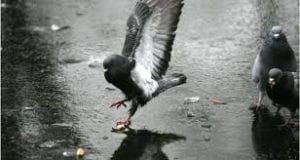How Did the Pigeon Get to NYC? One can scarcely think of any park in NYC — or any city, really — without envisioning the ubiquitous pigeon there as well. Despite signs requesting you not feed the birds in adjacent Bryant Park, the library has more than its share of feathered patrons.
But how did this non-native species become the bird most associated with New York City? Pigeons are certainly not indigenous, but they have made themselves quite at home in the Big Apple. In Wild New York: A Guide to the Wildlife, Wild Places, & Natural Phenomena of New York City, authors Margaret Mittelbach and Michael Crewdson explain “Also called rock doves, pigeons were first brought to this country from Europe, probably during the 1600s, and that their original status here was that of a barnyard animal, raised purely for the table.”
Captive pigeons somehow struck out on their own, nesting easily in the crevices of buildings that are not that different than the cliff sides on which their ancestors dwelled. Over time, pigeons and their young squab dwindle from menus and dinner tables. Ironically, most city pigeons depend exclusively on humans to feed them, whether purposefully or accidentally through litter.
to feed them, whether purposefully or accidentally through litter.
Thousands of years ago in North Africa, people built dovecotes to house and raise pigeons for food and to use their droppings as fertilizers. New Yorkers have kept a similar relationship with pigeons by building coops on building rooftops and raising pigeons for racing and companionship. Bert on Sesame Street famously loves pigeons, enough to sing about it. Scientist Nikola Tesla was extremely fond of pigeons and would frequent NYC parks searching for injured birds, which he would then bring back to his residence at the Hotel New Yorker to nurse them back to health. His obsession with pigeons is documented in the novel The Invention of Everything Else and he had a favorite pigeon, which he mourned when she died.
The New York Times has covered pigeons in abundance and there are many non-fiction titles out there to help you learn more about these birds such as Pigeons: The Fascinating Saga of the World’s Most Revered and Reviled Bird by Andrew D. Blechman. There are pigeon appreciation groups and documentaries by local filmmakers, such as JL Aronson’s Up on the Roof. Pigeons are definitely part of New York’s wildlife and landscape.
At Pigeon Patrol, we manufacture and offer a variety of bird deterrents, ranging from Ultra-flex Bird Spikes with UV protection, Bird Netting, 4-S Gel and the best Ultrasonic and audible sound devices on the market today.
Contact us at 1- 877– 4– NO-BIRD, (604) 585-9279 or visit our website at www.pigeonpatrol.ca
Bird Gone, Pigeon Gone, Seagull Gone, Pigeon issue, pigeon spikes, 1-877-4NO-BIRD, 4-S Gel, Bird Control, Pigeon Control, bird repellent, Bird Spikes, sonic bird repellent, stainless steel bird spikes, bird spikes Vancouver, Ultra Sonic Bird Control, Bird Netting, Plastic Bird Spikes, Canada bird spike deterrents, Pigeon Pests, B Gone Pigeon, Pigeon Patrol, pest controller, pest control operator, pest control technician, Pigeon Control Products, humane pigeon spikes, pigeon deterrents, pigeon traps, Pigeon repellents, Sound & Laser Deterrents, wildlife control, raccoon, skunk, squirrel deterrent, De-Fence Spikes, Dragons Den, Canada bird spikes, Canada pigeon, pigeon control, pigeon patrol, pigeon. Kill pigeons, crow, starling
